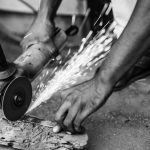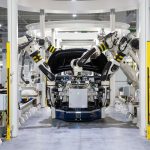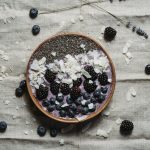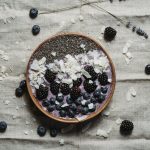You can speed up coconut harvesting by designing a sturdy, efficient dehusking machine that reduces labor and boosts productivity. Focus on durable materials, safety features like guards and emergency stops, and mechanisms such as blades or rollers to remove husks without damaging the kernel. This approach solves manual challenges like fatigue and slow processing, improving farm profitability and sustainability. Keep exploring, and you’ll discover how smart design choices and fabrication methods make a real difference.
Table of Contents
Key Takeaways
- A coconut dehusking machine improves harvesting efficiency by reducing labor time and physical strain.
- Designs often incorporate blade or roller mechanisms to effectively remove tough coconut husks without damaging the kernel.
- Durable materials and robust construction ensure the machine withstands repeated impact and pressure during operation.
- Safety features like protective guards, emergency stop buttons, and stable bases are critical for operator protection.
- Fabrication includes precise alignment and assembly of cutting or abrasion components for optimal husk removal performance.
Importance of Coconut Dehusking in Agriculture
Although it might seem like a simple step, coconut dehusking plays an essential role in agriculture by making the harvesting process faster and more efficient.
When you remove the tough outer husk quickly, you reduce labor time and increase productivity. This efficiency helps you handle larger quantities of coconuts, supporting better supply chain management.
Dehusking also prepares the coconut for further processing, whether for oil extraction, copra production, or sale as fresh nuts. By streamlining this step, you minimize damage to the inner shell and kernel, preserving quality.
Efficient dehusking safeguards the coconut’s inner quality, enhancing oil extraction, copra production, and fresh nut sales.
Ultimately, effective dehusking boosts your profitability and sustainability on the farm, enabling you to meet market demands with less effort and cost.
Challenges in Manual Coconut Dehusking
You know manual coconut dehusking takes a lot of hard work and can wear you out quickly.
It also eats up a significant amount of your time, slowing down the entire process.
Let’s look at how these challenges affect your productivity.
Labor Intensity Issues
When you manually dehusk coconuts, you quickly realize how physically demanding the task is. The process requires intense force and repetitive motions, which can quickly wear you down. This labor intensity often leads to fatigue and increases the risk of injury.
You also need significant upper body strength to handle each coconut effectively. Here are some key labor-related challenges you face:
- Strain from repetitive striking motions causing muscle fatigue
- Risk of hand and arm injuries from slipping tools or sharp husks
- Physical exhaustion from continuously lifting and positioning heavy coconuts
These factors make manual dehusking exhausting and potentially hazardous, emphasizing the need for mechanized solutions to reduce the physical burden on workers.
Time Consumption Challenges
Beyond the physical strain, manual coconut dehusking demands a significant amount of time. When you rely on traditional methods, you spend minutes or even hours removing the husk from each coconut.
This slow process limits how many coconuts you can handle daily, reducing overall productivity. You also face delays when dealing with tough or partially dried husks, which take longer to remove.
The repetitive nature of the task means fatigue sets in, further slowing your pace. If you’re managing a larger operation, these time consumption challenges add up, increasing labor costs and delaying downstream processing.
Key Design Principles for Dehusking Machines
Although dehusking coconuts might seem straightforward, designing an effective machine requires careful attention to several key principles. You need to guarantee the machine operates efficiently, safely, and sustainably.
First, consider the machine’s durability—coconuts are tough, so your design must withstand repeated impact and pressure.
Second, focus on user safety by incorporating guards and emergency stops to prevent accidents.
Third, optimize the machine for minimal coconut damage to preserve the kernel’s quality.
Key design principles include:
- Robust construction to handle the coconut’s hardness
- Safety features that protect the operator
- Efficient husk removal without damaging the nut inside
Types of Mechanical Dehusking Mechanisms
When choosing a mechanical dehusking machine, you’ll find two main types of mechanisms: blade-based systems and roller with abrasion methods.
Each works differently to strip the coconut husk efficiently.
Let’s explore how these mechanisms handle the tough outer layer.
Blade-based Dehusking Systems
Blade-based dehusking systems use sharp, rotating blades to strip the outer husk from coconuts efficiently.
You’ll find these systems ideal when you need quick, consistent husking without damaging the nut inside. The blades cut through the tough fibers, separating the husk cleanly.
When choosing or designing one, consider these key aspects:
- Blade design: Curved or straight blades affect cutting efficiency and husk removal.
- Rotation speed: Higher speeds increase throughput but require careful control to avoid nut damage.
- Safety features: Guards and emergency stops protect operators from sharp blades.
Roller and Abrasion Methods
Since coconuts have tough outer layers, roller and abrasion methods offer an effective way to remove husks without relying on sharp blades.
You can use rollers that grip and pull the husk away by applying controlled pressure. These rollers often have textured surfaces to increase friction, helping to loosen the fibrous outer layers.
Abrasion methods work by rubbing the coconut against rough surfaces or abrasive materials, gradually wearing down the husk until it separates.
When designing your machine, consider adjustable roller speed and pressure to accommodate different coconut sizes and husk thicknesses.
Abrasion surfaces should be durable and replaceable to maintain efficiency.
These methods reduce the risk of damaging the coconut kernel and improve safety, making them a practical choice in mechanical dehusking systems.
Materials and Components Used in Fabrication
Although the design of a coconut dehusking machine varies, you’ll find that selecting durable materials and reliable components is crucial for efficient performance.
The machine’s frame usually needs strong metals like mild steel or stainless steel to withstand constant stress and environmental exposure. For moving parts such as rollers and blades, hardened steel is preferred due to its wear resistance and sharpness retention.
Additionally, you’ll want components that balance strength with ease of maintenance.
Key materials and components include:
- Mild or stainless steel frame: Offers structural integrity and corrosion resistance
- Hardened steel rollers/blades: Guarantees effective dehusking and longevity
- Bearings and shafts: Facilitate smooth rotation and reduce friction
Choosing these wisely guarantees your machine operates reliably and lasts longer.
Safety Features and Operational Considerations
How do you guarantee safe operation while maximizing efficiency in a coconut dehusking machine? You start by integrating essential safety features such as emergency stop buttons and protective guards around moving parts to prevent accidental contact.
Verify the machine has stable, non-slip bases to avoid tipping during operation. Regular maintenance checks are vital to keep all components functioning properly and to identify wear that could cause hazards.
Train operators thoroughly on correct usage, emphasizing the importance of wearing protective gear like gloves and safety glasses. Avoid overloading the machine, as excessive force can lead to mechanical failure or injuries.
Impact of Dehusking Machines on Productivity and Local Economy
When you introduce a coconut dehusking machine, you’ll see a significant boost in productivity because it speeds up the husking process and reduces manual labor.
This efficiency lets you process more coconuts daily, increasing output and meeting market demand faster.
Additionally, the machine’s use creates economic opportunities in your community by:
- Lowering labor costs and minimizing physical strain on workers
- Enabling small-scale farmers and entrepreneurs to expand their businesses
- Generating local employment through machine operation and maintenance
Frequently Asked Questions
What Is the Average Lifespan of a Coconut Dehusking Machine?
You can expect a coconut dehusking machine to last around 5 to 10 years with regular maintenance. Proper care, timely repairs, and using quality parts will help you keep it running efficiently for a long time.
How Much Does a Typical Coconut Dehusking Machine Cost?
Picture a sturdy machine humming as it peels coconuts effortlessly. You’ll find typical coconut dehusking machines cost between $500 and $2,000, depending on size, features, and build quality, fitting various budgets and needs.
Are There Any Environmental Impacts From Using Dehusking Machines?
Yes, using dehusking machines can cause environmental impacts like energy consumption and noise pollution. However, you can reduce these effects by choosing energy-efficient models and maintaining the machine properly to minimize waste and emissions.
Can the Machine Be Used for Other Types of Nuts or Fruits?
Imagine trying to open a stubborn jar with a key—it won’t work. Similarly, you can’t use a coconut dehusking machine for other nuts or fruits, as each requires a unique tool tailored to its shell or skin.
What Maintenance Schedule Is Recommended for These Machines?
You should clean the machine after each use, lubricate moving parts weekly, and inspect blades monthly. Regular maintenance guarantees smooth operation, prevents breakdowns, and extends the machine’s lifespan. Don’t skip scheduled checks!
- Does Chiffon Fabric Stink - July 15, 2025
- Does Chiffon Fabric Affect the Economy - July 15, 2025
- Does Cotton Fabric Have a Nap - July 15, 2025







